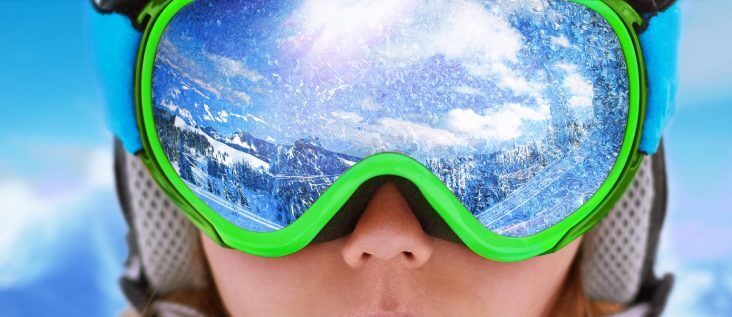Some people think that wearing sunglasses is sufficient, when they head out to enjoy winter sports. However, when partaking in many winter sporting activities, like skiing, snowboarding, and snowshoeing, a good pair of sunglasses is no match for a great pair of snow goggles. There are many advantages that snow goggles offer over sunglasses. Making many winter activities much more enjoyable!
The Advantages Of Snow Goggles
Like sunglasses wearing snow goggles can help the wearer enjoy and perform better in the activity they are doing. Snow glasses offer many benefits. They can help protect your eyes from harmful ultraviolet (UV) rays. As well as also offering colour and contrast enhancement. As well as providing safety protection for both your eyes and face.
Selecting A Snow Goggle
When deciding on a pair of snow goggles. You should make sure that the pair of goggles you are selecting has 100% UV protection. If anti-fog is an option, go for it! If not, look for a goggle that has wide side vents. This will help prevent the goggles from fogging up.
Snow Goggles: The Fit
When selecting a goggle, one should look for a goggle made from a flexible material that holds it’s shape. Softer materials, such as rubber and nylon doesn’t get brittle in the cold and is better at protecting the face from injury in the event that you fall or get hit by an object when traveling at high speeds. It should fit the face comfortable with enough pressure that it stays in place without the goggle hurting the skin. The goggle should have a thick strap that goes behind the head. This will help hold the goggle in place.
Snow goggles should fit snugly around the eye area. A close fit help prevent both debris, such as snow and ice from entering in behind the goggle. It also helps eliminate any unwanted reflective glare from reaching the eyes as well.
Options For Vision Correction
If you require vision correction, wearing contact lenses under snow goggles to be able to see is a great option. However, there are some people who are unable to wear contacts. For those individuals selecting a snow goggle which is large enough to fit over your prescription eyeglasses may be an option. Some goggles also have inserts, that can have a perscription fitted to them. The insert then snaps into place within the goggles.
The Snow Goggle Lens
The size of snow goggles is also important. Goggles typically come with one large lens, called a shield. A shield is generally just one great big large lens! The large size of the shield helps eliminate any distractions and blind spots caused by a frame. Wearing a regular pair of eyeglasses and sunglasses. The shields come in a variety of colours, including clear. They also come in polarized and non polarized options.
The Goggle Colour
When selecting the goggle lens/shield, think about where and in what light conditions you will be wearing your snow goggles. Snow goggle lens colours such as yellow and orange are very popular. These colours block the blue/hazy colours of the colour spectrum. They are often referred to as blue blockers. Because they block colours that tend to look hazy, they help enhance vision. They also enhance colour and contrast. This allows the wearer to see shapes and objects, as well as contours in the hill more clearly.
Rose, copper, and brown lenses also offer colour contrast. They are a great choice for low light conditions or flat light, cloudy days.
Darker lens colours such as grey, and dark brown perform great on bright sunny days. They provide the most reduction in visible light from reaching the eyes.
Mirror tints are great for helping to reduce reflective light. This is also a great choice for bright days with lots of reflective glare.
For very low light conditions, such as at sunset or dusk, it’s best to use a clear lens. The clear lens allows the most amount of light through the lens, while still providing the safety aspect of having the goggle shield protect the eyes.
Light conditions can change dependent on weather as well as time of day. Because of this, it is a good idea to choose a pair of snow goggles that offers interchangeable lenses. Having the flexibility to change the colour of lens will allow you to change lenses based on different visual needs and light conditions. This will enable you to have the best visual experience possible when performing your activity.
Polarized Lenses
Polarized lenses are great for reducing glare and reflection from snow and ice. They come in a variety of colours. The majority of times, polarized lenses are great! However, dependent on light conditions, they sometimes are not recommended on the slopes. This is because they reduce the “bounce back”, reflective light. Because reflective light is reduced, when wearing polarized lenses, the wearer may be unable to see patches of ice.
If you have any questions regarding snow goggles, or vision options for different activities talk to your eye care practitioner. They are the best resource to offer you the best advice for solutions regarding your visual needs.
Article Written By: Karen McAulay

